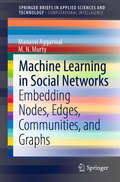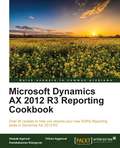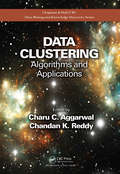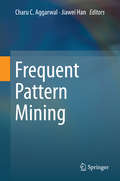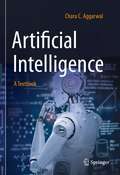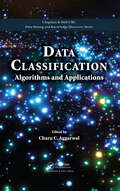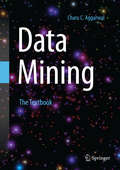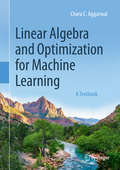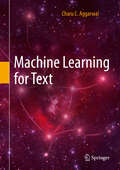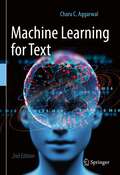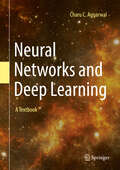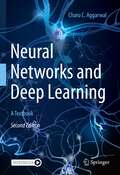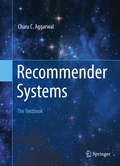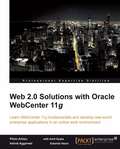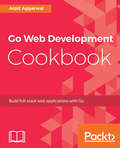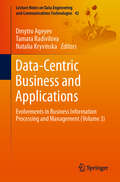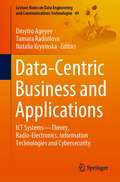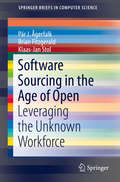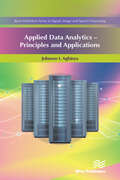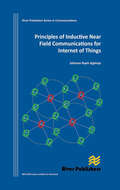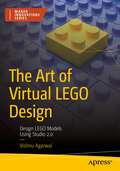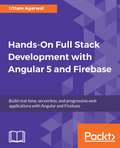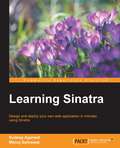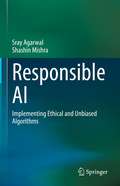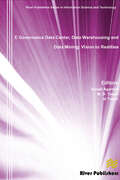- Table View
- List View
Machine Learning in Social Networks: Embedding Nodes, Edges, Communities, and Graphs (SpringerBriefs in Applied Sciences and Technology)
by Manasvi Aggarwal M.N. MurtyThis book deals with network representation learning. It deals with embedding nodes, edges, subgraphs and graphs. There is a growing interest in understanding complex systems in different domains including health, education, agriculture and transportation. Such complex systems are analyzed by modeling, using networks that are aptly called complex networks. Networks are becoming ubiquitous as they can represent many real-world relational data, for instance, information networks, molecular structures, telecommunication networks and protein–protein interaction networks. Analysis of these networks provides advantages in many fields such as recommendation (recommending friends in a social network), biological field (deducing connections between proteins for treating new diseases) and community detection (grouping users of a social network according to their interests) by leveraging the latent information of networks. An active and important area of current interest is to come out with algorithms that learn features by embedding nodes or (sub)graphs into a vector space. These tasks come under the broad umbrella of representation learning. A representation learning model learns a mapping function that transforms the graphs' structure information to a low-/high-dimension vector space maintaining all the relevant properties.
Microsoft Dynamics AX 2012 R3 Reporting Cookbook
by Chhavi Aggarwal Deepak AgarwalMicrosoft Dynamics AX 2012 R3 Reporting Cookbook is recommended for Dynamics AX developers and .NET-based SSRS developers looking to familiarize themselves with the new AX reporting framework.
Data Clustering: Algorithms and Applications (Chapman & Hall/CRC Data Mining and Knowledge Discovery Series #31)
by Charu C. Aggarwal Chandan K. ReddyResearch on the problem of clustering tends to be fragmented across the pattern recognition, database, data mining, and machine learning communities. Addressing this problem in a unified way, Data Clustering: Algorithms and Applications provides complete coverage of the entire area of clustering, from basic methods to more refined and complex data clustering approaches. It pays special attention to recent issues in graphs, social networks, and other domains.The book focuses on three primary aspects of data clustering: Methods, describing key techniques commonly used for clustering, such as feature selection, agglomerative clustering, partitional clustering, density-based clustering, probabilistic clustering, grid-based clustering, spectral clustering, and nonnegative matrix factorization Domains, covering methods used for different domains of data, such as categorical data, text data, multimedia data, graph data, biological data, stream data, uncertain data, time series clustering, high-dimensional clustering, and big data Variations and Insights, discussing important variations of the clustering process, such as semisupervised clustering, interactive clustering, multiview clustering, cluster ensembles, and cluster validation In this book, top researchers from around the world explore the characteristics of clustering problems in a variety of application areas. They also explain how to glean detailed insight from the clustering process—including how to verify the quality of the underlying clusters—through supervision, human intervention, or the automated generation of alternative clusters.
Frequent Pattern Mining
by Charu C. Aggarwal Jiawei HanThis comprehensive reference consists of 18 chapters from prominent researchers in the field. Each chapter is self-contained, and synthesizes one aspect of frequent pattern mining. An emphasis is placed on simplifying the content, so that students and practitioners can benefit from the book. Each chapter contains a survey describing key research on the topic, a case study and future directions. Key topics include: Pattern Growth Methods, Frequent Pattern Mining in Data Streams, Mining Graph Patterns, Big Data Frequent Pattern Mining, Algorithms for Data Clustering and more. Advanced-level students in computer science, researchers and practitioners from industry will find this book an invaluable reference.
Artificial Intelligence: A Textbook
by Charu C. AggarwalThis textbook covers the broader field of artificial intelligence. The chapters for this textbook span within three categories:Deductive reasoning methods: These methods start with pre-defined hypotheses and reason with them in order to arrive at logically sound conclusions. The underlying methods include search and logic-based methods. These methods are discussed in Chapters 1through 5.Inductive Learning Methods: These methods start with examples and use statistical methods in order to arrive at hypotheses. Examples include regression modeling, support vector machines, neural networks, reinforcement learning, unsupervised learning, and probabilistic graphical models. These methods are discussed in Chapters~6 through 11. Integrating Reasoning and Learning: Chapters~11 and 12 discuss techniques for integrating reasoning and learning. Examples include the use of knowledge graphs and neuro-symbolic artificial intelligence.The primary audience for this textbook are professors and advanced-level students in computer science. It is also possible to use this textbook for the mathematics requirements for an undergraduate data science course. Professionals working in this related field many also find this textbook useful as a reference.
Data Classification: Algorithms and Applications (Chapman And Hall/crc Data Mining And Knowledge Discovery Ser. #35)
by Charu C. AggarwalComprehensive Coverage of the Entire Area of ClassificationResearch on the problem of classification tends to be fragmented across such areas as pattern recognition, database, data mining, and machine learning. Addressing the work of these different communities in a unified way, Data Classification: Algorithms and Applications explores the underlyi
Data Mining: The Textbook (Chapman And Hall/crc Data Mining And Knowledge Discovery Ser. #31)
by Charu C. AggarwalThis textbook explores the different aspects of data mining from the fundamentals to the complex data types and their applications, capturing the wide diversity of problem domains for data mining issues. It goes beyond the traditional focus on data mining problems to introduce advanced data types such as text, time series, discrete sequences, spatial data, graph data, and social networks. Until now, no single book has addressed all these topics in a comprehensive and integrated way. The chapters of this book fall into one of three categories: Fundamental chapters: Data mining has four main problems, which correspond to clustering, classification, association pattern mining, and outlier analysis. These chapters comprehensively discuss a wide variety of methods for these problems. Domain chapters: These chapters discuss the specific methods used for different domains of data such as text data, time-series data, sequence data, graph data, and spatial data. Application chapters: These chapters study important applications such as stream mining, Web mining, ranking, recommendations, social networks, and privacy preservation. The domain chapters also have an applied flavor. Appropriate for both introductory and advanced data mining courses, Data Mining: The Textbook balances mathematical details and intuition. It contains the necessary mathematical details for professors and researchers, but it is presented in a simple and intuitive style to improve accessibility for students and industrial practitioners (including those with a limited mathematical background). Numerous illustrations, examples, and exercises are included, with an emphasis on semantically interpretable examples. Praise for Data Mining: The Textbook - "As I read through this book, I have already decided to use it in my classes. This is a book written by an outstanding researcher who has made fundamental contributions to data mining, in a way that is both accessible and up to date. The book is complete with theory and practical use cases. It's a must-have for students and professors alike!" -- Qiang Yang, Chair of Computer Science and Engineering at Hong Kong University of Science and Technology "This is the most amazing and comprehensive text book on data mining. It covers not only the fundamental problems, such as clustering, classification, outliers and frequent patterns, and different data types, including text, time series, sequences, spatial data and graphs, but also various applications, such as recommenders, Web, social network and privacy. It is a great book for graduate students and researchers as well as practitioners. " -- Philip S. Yu, UIC Distinguished Professor and Wexler Chair in Information Technology at University of Illinois at Chicago
Linear Algebra and Optimization for Machine Learning: A Textbook
by Charu C. AggarwalThis textbook introduces linear algebra and optimization in the context of machine learning. Examples and exercises are provided throughout this text book together with access to a solution’s manual. This textbook targets graduate level students and professors in computer science, mathematics and data science. Advanced undergraduate students can also use this textbook. The chapters for this textbook are organized as follows:1. Linear algebra and its applications: The chapters focus on the basics of linear algebra together with their common applications to singular value decomposition, matrix factorization, similarity matrices (kernel methods), and graph analysis. Numerous machine learning applications have been used as examples, such as spectral clustering, kernel-based classification, and outlier detection. The tight integration of linear algebra methods with examples from machine learning differentiates this book from generic volumes on linear algebra. The focus is clearly on the most relevant aspects of linear algebra for machine learning and to teach readers how to apply these concepts.2. Optimization and its applications: Much of machine learning is posed as an optimization problem in which we try to maximize the accuracy of regression and classification models. The “parent problem” of optimization-centric machine learning is least-squares regression. Interestingly, this problem arises in both linear algebra and optimization, and is one of the key connecting problems of the two fields. Least-squares regression is also the starting point for support vector machines, logistic regression, and recommender systems. Furthermore, the methods for dimensionality reduction and matrix factorization also require the development of optimization methods. A general view of optimization in computational graphs is discussed together with its applications to back propagation in neural networks. A frequent challenge faced by beginners in machine learning is the extensive background required in linear algebra and optimization. One problem is that the existing linear algebra and optimization courses are not specific to machine learning; therefore, one would typically have to complete more course material than is necessary to pick up machine learning. Furthermore, certain types of ideas and tricks from optimization and linear algebra recur more frequently in machine learning than other application-centric settings. Therefore, there is significant value in developing a view of linear algebra and optimization that is better suited to the specific perspective of machine learning.
Machine Learning for Text
by Charu C. AggarwalText analytics is a field that lies on the interface of information retrieval,machine learning, and natural language processing, and this textbook carefully covers a coherently organized framework drawn from these intersecting topics. The chapters of this textbook is organized into three categories:- Basic algorithms: Chapters 1 through 7 discuss the classical algorithms for machine learning from text such as preprocessing, similarity computation, topic modeling, matrix factorization, clustering, classification, regression, and ensemble analysis.- Domain-sensitive mining: Chapters 8 and 9 discuss the learning methods from text when combined with different domains such as multimedia and the Web. The problem of information retrieval and Web search is also discussed in the context of its relationship with ranking and machine learning methods. - Sequence-centric mining: Chapters 10 through 14 discuss various sequence-centric and natural language applications, such as feature engineering, neural language models, deep learning, text summarization, information extraction, opinion mining, text segmentation, and event detection. This textbook covers machine learning topics for text in detail. Since the coverage is extensive,multiple courses can be offered from the same book, depending on course level. Even though the presentation is text-centric, Chapters 3 to 7 cover machine learning algorithms that are often used indomains beyond text data. Therefore, the book can be used to offer courses not just in text analytics but also from the broader perspective of machine learning (with text as a backdrop). This textbook targets graduate students in computer science, as well as researchers, professors, and industrial practitioners working in these related fields. This textbook is accompanied with a solution manual for classroom teaching.
Machine Learning for Text
by Charu C. AggarwalThis second edition textbook covers a coherently organized framework for text analytics, which integrates material drawn from the intersecting topics of information retrieval, machine learning, and natural language processing. Particular importance is placed on deep learning methods. The chapters of this book span three broad categories:1. Basic algorithms: Chapters 1 through 7 discuss the classical algorithms for text analytics such as preprocessing, similarity computation, topic modeling, matrix factorization, clustering, classification, regression, and ensemble analysis.2. Domain-sensitive learning and information retrieval: Chapters 8 and 9 discuss learning models in heterogeneous settings such as a combination of text with multimedia or Web links. The problem of information retrieval and Web search is also discussed in the context of its relationship with ranking and machine learning methods. 3. Natural language processing: Chapters 10 through 16 discuss various sequence-centric and natural language applications, such as feature engineering, neural language models, deep learning, transformers, pre-trained language models, text summarization, information extraction, knowledge graphs, question answering, opinion mining, text segmentation, and event detection. Compared to the first edition, this second edition textbook (which targets mostly advanced level students majoring in computer science and math) has substantially more material on deep learning and natural language processing. Significant focus is placed on topics like transformers, pre-trained language models, knowledge graphs, and question answering.
Neural Networks and Deep Learning: A Textbook
by Charu C. AggarwalThis book covers both classical and modern models in deep learning. The primary focus is on the theory and algorithms of deep learning. The theory and algorithms of neural networks are particularly important for understanding important concepts, so that one can understand the important design concepts of neural architectures in different applications. Why do neural networks work? When do they work better than off-the-shelf machine-learning models? When is depth useful? Why is training neural networks so hard? What are the pitfalls? The book is also rich in discussing different applications in order to give the practitioner a flavor of how neural architectures are designed for different types of problems. Applications associated with many different areas like recommender systems, machine translation, image captioning, image classification, reinforcement-learning based gaming, and text analytics are covered. The chapters of this book span three categories: The basics of neural networks: Many traditional machine learning models can be understood as special cases of neural networks. An emphasis is placed in the first two chapters on understanding the relationship between traditional machine learning and neural networks. Support vector machines, linear/logistic regression, singular value decomposition, matrix factorization, and recommender systems are shown to be special cases of neural networks. These methods are studied together with recent feature engineering methods like word2vec. Fundamentals of neural networks: A detailed discussion of training and regularization is provided in Chapters 3 and 4. Chapters 5 and 6 present radial-basis function (RBF) networks and restricted Boltzmann machines. Advanced topics in neural networks: Chapters 7 and 8 discuss recurrent neural networks and convolutional neural networks. Several advanced topics like deep reinforcement learning, neural Turing machines, Kohonen self-organizing maps, and generative adversarial networks are introduced in Chapters 9 and 10. The book is written for graduate students, researchers, and practitioners. Numerous exercises are available along with a solution manual to aid in classroom teaching. Where possible, an application-centric view is highlighted in order to provide an understanding of the practical uses of each class of techniques.
Neural Networks and Deep Learning: A Textbook
by Charu C. AggarwalThis textbook covers both classical and modern models in deep learning and includes examples and exercises throughout the chapters. Deep learning methods for various data domains, such as text, images, and graphs are presented in detail. The chapters of this book span three categories: The basics of neural networks: The backpropagation algorithm is discussed in Chapter 2.Many traditional machine learning models can be understood as special cases of neural networks. Chapter 3 explores the connections between traditional machine learning and neural networks. Support vector machines, linear/logistic regression, singular value decomposition, matrix factorization, and recommender systems are shown to be special cases of neural networks. Fundamentals of neural networks: A detailed discussion of training and regularization is provided in Chapters 4 and 5. Chapters 6 and 7 present radial-basis function (RBF) networks and restricted Boltzmann machines. Advanced topics in neural networks: Chapters 8, 9, and 10 discuss recurrent neural networks, convolutional neural networks, and graph neural networks. Several advanced topics like deep reinforcement learning, attention mechanisms, transformer networks, Kohonen self-organizing maps, and generative adversarial networks are introduced in Chapters 11 and 12. The textbook is written for graduate students and upper under graduate level students. Researchers and practitioners working within this related field will want to purchase this as well.Where possible, an application-centric view is highlighted in order to provide an understanding of the practical uses of each class of techniques.The second edition is substantially reorganized and expanded with separate chapters on backpropagation and graph neural networks. Many chapters have been significantly revised over the first edition.Greater focus is placed on modern deep learning ideas such as attention mechanisms, transformers, and pre-trained language models.
Recommender Systems
by Charu C. AggarwalThisbook comprehensively covers the topic of recommender systems, which providepersonalized recommendations of products or services to users based on theirprevious searches or purchases. Recommender system methods have been adapted todiverse applications including query log mining, social networking, newsrecommendations, and computational advertising. This book synthesizes bothfundamental and advanced topics of a research area that has now reachedmaturity. The chapters of this book are organized into three categories: - Algorithms and evaluation: Thesechapters discuss the fundamental algorithms in recommender systems, includingcollaborative filtering methods, content-based methods, knowledge-basedmethods, ensemble-based methods, and evaluation. - Recommendations in specific domains and contexts: the context of a recommendationcan be viewed as important side information that affects the recommendationgoals. Different types of context such as temporal data, spatial data, socialdata, tagging data, and trustworthiness are explored. - Advanced topics and applications: Various robustness aspects of recommender systems, such as shillingsystems, attack models, and their defenses are discussed. Inaddition, recent topics, such as learning to rank, multi-armed bandits, groupsystems, multi-criteria systems, and active learning systems, are introducedtogether with applications. Although this book primarily serves as atextbook, it will also appeal to industrial practitioners and researchers dueto its focus on applications and references. Numerous examples and exerciseshave been provided, and a solution manual is available for instructors.
Web 2.0 Solutions with Oracle WebCenter 11g
by Ashok Aggarwal Plinio ArbizuThe book starts by explaining the context of the WEB 2.0 platform. It helps the reader to understand its main features and their application in organizations. It shows how the Oracle WebCenter technology can help you implement the Web 2.0 solutions. In each chapter, the theoretical concepts are tested with the help of practical applications. The apt recommendations and suggestions are other key points of the book. Filled with careful step-by-step instructions and plenty of screenshots, this tutorial shows you how to get the most out of the WebCenter Suite 11g. You will learn about integrating various services to enhance your Web 2.0 solutions using Oracle WebCenter. This book is for web developers who need to improve their websites or business applications using Web 2.0 features. This book is recommended for you, if you are a: Portal Developer who works with a traditional portal and wants to move onto new technologies Java Developer and want to add productivity features to your business applications Knowledge Managers and want to create collaborative environments and increase the productivity of your employees and organizational groups
Go Web Development Cookbook: Build full-stack web applications with Go
by Arpit Aggarwal86 recipes on how to build fast, scalable, and powerful web services and applications with GoKey FeaturesBecome proficient in RESTful web servicesBuild scalable, high-performant web applications in GoGet acquainted with Go frameworks for web developmentBook DescriptionGo is an open source programming language that is designed to scale and support concurrency at the language level. This gives you the liberty to write large concurrent web applications with ease. From creating web application to deploying them on Amazon Cloud Services, this book will be your one-stop guide to learn web development in Go. The Go Web Development Cookbook teaches you how to create REST services, write microservices, and deploy Go Docker containers. Whether you are new to programming or a professional developer, this book will help get you up to speed with web development in Go. We will focus on writing modular code in Go; in-depth informative examples build the base, one step at a time. You will learn how to create a server, work with static files, SQL, NoSQL databases, and Beego. You will also learn how to create and secure REST services, and create and deploy Go web application and Go Docker containers on Amazon Cloud Services. By the end of the book, you will be able to apply the skills you've gained in Go to create and explore web applications in any domain.What you will learn Create a simple HTTP and TCP web server and understand how it works Explore record in a MySQL and MongoDB database Write and consume RESTful web service in Go Invent microservices in Go using Micro – a microservice toolkit Create and Deploy the Beego application with Nginx Deploy Go web application and Docker containers on an AWS EC2 instanceWho this book is forThis book is for Go developers interested in learning how to use Go to build powerful web applications. A background in web development is expected.
Data-Centric Business and Applications: Evolvements in Business Information Processing and Management (Volume 3) (Lecture Notes on Data Engineering and Communications Technologies #42)
by Dmytro Ageyev Tamara Radivilova Natalia KryvinskaBuilding on the authors’ previous work, this book addresses key processes and procedures used in information/data processing and management. Modern methods of business information processing, which draw on artificial intelligence, big data, and cloud-based storage and processing, are opening exciting new opportunities for doing business on the basis of information technologies. Thus, in this third book, the authors continue to explore various aspects – technological as well as business and social – of the information industries. Further, they analyze the challenges and opportunities entailed by these kinds of business.
Data-Centric Business and Applications: ICT Systems—Theory, Radio-Electronics, Information Technologies and Cybersecurity (Lecture Notes on Data Engineering and Communications Technologies #69)
by Dmytro Ageyev Tamara Radivilova Natalia KryvinskaThis book, building on the authors’ previous work, presents new communication and networking technologies, challenges and opportunities of information/data processing and transmission. It also discusses the development of more intelligent and efficient communication technologies, which are an essential part of current day-to-day life. Information and Communication Technologies (ICTs) have an enormous impact on businesses and our day-to-day lives over the past three decades and continue to do so. Modern methods of business information processing are opening exciting new opportunities for doing business on the basis of information technologies. The book contains research that spans a wide range of communication and networking technologies, including wireless sensor networks, optical and telecommunication networks, storage area networks, error-free transmission and signal processing.
Software Sourcing in the Age of Open
by Pär J. Ågerfalk Brian Fitzgerald Klaas-Jan StolThis SpringerBrief discusses multiple forms of open-source-inspired outsourcing: opensourcing, innersourcing and crowdsourcing. It uses a framework-based comparison to explain the strengths and weaknesses of each approach. By pointing out characteristics along with benefits and pitfalls of each approach, the authors provide nuanced and research-based advice to managers and developers facing software sourcing decisions. The differences and commonalities of these three emerging approaches are carefully analyzed. Chapters explore the primary challenges of reliability, efficiency and robustness in open-source methods. Examples from industrial cases are included, along with extensive references to recent research. The brief concludes with a comparative analysis of approaches and outlines key implications to be aware of when outsourcing. Software Sourcing in the Age of Open: Leveraging the Unknown Workforce is designed for professionals and researchers interested in outsourcing challenges. The content is also suitable for postgraduate students interested in contemporary software sourcing approaches.
Applied Data Analytics - Principles and Applications
by Johnson I. AgbinyaThe emergence of huge amounts of data which require analysis and in some cases real-time processing has forced exploration into fast algorithms for handling very lage data sizes. Analysis of x-ray images in medical applications, cyber security data, crime data, telecommunications and stock market data, health records and business analytics data are but a few areas of interest. Applications and platforms including R, RapidMiner and Weka provide the basis for analysis, often used by practitioners who pay little to no attention to the underlying mathematics and processes impacting the data. This often leads to an inability to explain results or correct mistakes, or to spot errors.Applied Data Analytics - Principles and Applications seeks to bridge this missing gap by providing some of the most sought after techniques in big data analytics. Establishing strong foundations in these topics provides practical ease when big data analyses are undertaken using the widely available open source and commercially orientated computation platforms, languages and visualisation systems. The book, when combined with such platforms, provides a complete set of tools required to handle big data and can lead to fast implementations and applications.The book contains a mixture of machine learning foundations, deep learning, artificial intelligence, statistics and evolutionary learning mathematics written from the usage point of view with rich explanations on what the concepts mean. The author has thus avoided the complexities often associated with these concepts when found in research papers. The tutorial nature of the book and the applications provided are some of the reasons why the book is suitable for undergraduate, postgraduate and big data analytics enthusiasts.This text should ease the fear of mathematics often associated with practical data analytics and support rapid applications in artificial intelligence, environmental sensor data modelling and analysis, health informatics, business data analytics, data from Internet of Things and deep learning applications.
Principles of Inductive Near Field Communications for Internet of Things
by Johnson I. AgbinyaNear field communication devices and the emerging field of Internet of things require efficient short range communication techniques. Classical telecommunication theory however has so far focused on radiating electromagnetic signals which is more suited to terrestrial communication systems. Over the last decade however considerable research and applications of inductive methods have emerged as innovative approaches for secure short range communications by changing the paradigm of an established model of electromagnetic communications. We have witnessed the emergence of embedded inductive medical devices, magneto-inductive waveguides, inductive pots and cooking devices, magneto-inductive sensors, wireless power transfer, inductive hearing aids and the emerging inductive point-to-point communication specifically termed near-field communication (NFC) as used in mobile phones and payment cards to name a few. While there exist a large set of distributed methods and algorithms detailing the design and performances of such applications, a significant gap is observed as a lack of detailed collection of the methods in one place which could be easily understood and used quickly by someone seeking to apply the methods.In this book this missing gap is filled with the required details and the theory of near field communication systems including both the radiating and reactive (energy coupling) near-field systems in addition to the well known far field radiation techniques. The book details the fundamental expressions and design methods which facilitate the creation of near field devices and equipment including embedded biomedical implants. The book contains recent advances in inductive communications, performance, limitations and a collection of applications. It also lays a strong foundation for the application of inductive methods for creating Internet of Things systems.
The Art of Virtual LEGO Design: Design LEGO Models Using Studio 2.0
by Vishnu AgarwalHave you ever dreamed of designing your own LEGOs? Do you love building huge LEGO models, but don’t have enough bricks? This book will show you how to do all that and more with Bricklink Studio 2.0, a software program that's widely used by LEGO designers to create LEGO models virtually before making them with real LEGO bricks. You'll learn how to start a new project, use the camera control options, and drag and drop parts into your building plate. Then take your bricks from a pile of random pieces into intricate masterpiece models using building tools like Select, Hinge, Clone, Hide, Connect, Collision, and more! You’ll master all the building tools that help you build LEGO models. Then you’ll learn to search and manage LEGO bricks in Studio 2.0 using different palette options like Master, Hidden parts, and Custom parts. Beyond the official LEGO colors, there are special color options you can use to render neon, glow in the dark, and translucent brick. Use this expanded color palette to add to the complexity of your models, and then render your model to see it realistically in 3D! You’ll also learn to animate your model and watch it come to life. After finishing your design, you’ll learn to share what you’ve built with the world. You’ll create professional LEGO instructions for your model that can be printed or shared. Making you a true LEGO design master! What You'll LearnMake fascinating models with virtual LEGO bricks Design LEGO models more efficiently with Studio 2.0’s powerful tools Use “Build Together” simultaneously with another designer on the same project Build massive, amazing models on a small budget Who This Book Is ForAnyone interested in digital modelling or who loves building with LEGOs. Students, hobbyists, and enthusiasts will find fun learning activities.
Hands-On Full Stack Development with Angular 5 and Firebase: Build real-time, serverless, and progressive web applications with Angular and Firebase
by Uttam AgarwalBuild an end-to-end application from development to production by binding Angular with Firebase in this complete guide to web application development Key Features Build a real-time production-ready web application by leveraging the features of Angular as front end and Firebase as the back end Learn more about authentication, databases, and security with Firebase Learn how to grow your application user base using Google analytics and how to make your application PWA compliant. Book Description This book is a complete package for you to build real-time web applications. You will build an end-to-end social networking web application from development to production with Angular as the frontend and Firebase as the backend. You will create an application called Friends with authentication, friends, and chat features. During the process, you’ll use Firebase authentication to register new users and Firebase database to store your extra user data. You’ll take a look at how to store and retrieve your user's images from Firebase storage. Then, you’ll create a real-time chat module with the Firebase database. Next, you’ll secure your database using Firebase security, make your application live with Firebase hosting, and develop your application with analytics. Moving on, you’ll take a look at how to create web pages using bootstrap with HTML, CSS, and TypeScript. You will use the angularfire2 library API in Angular services to interact with Firebase and write unit tests using the Jasmine framework that will help you to write a production-ready application. You’ll also discover various debugging techniques to troubleshoot any bug in your application. Finally, you’ll make your application Progressive Web Applications compliant. By the end of this book, you’ll be able to confidently build any complex application. What you will learn Understand the core concepts of Angular framework Create web pages with Angular as front end and Firebase as back end Develop a real-time social networking application Make your application live with Firebase hosting Engage your user using Firebase cloud messaging Grow your application with Google analytics Learn about Progressive Web App Who this book is for This book is for JavaScript developers who have some previous knowledge of the Angular framework and want to start developing serverless applications with Angular and Firebase. If you are looking for a more practical and less theory-based approach to learn these concepts, then this book is for you.
Learning Sinatra
by Sudeep Agarwal Manoj SehrawatDesign and deploy your own web application in minutes using Sinatra About This Book * Exploit Sinatra to design a web application * Integrate external, internal, and inline CSS and use some popular CSS frameworks * Deploy an application onto your own server or on a cloud application platform Who This Book Is For Learning Sinatra is a great place to start your first Sinatra application. It doesn't matter whether you have written a web application before or not, though some basic knowledge of programming is essential. What You Will Learn * Install and set up Ruby and Sinatra * Work with layouts and template routes * Extend the code to include CSS in different ways * Create projects and understand MVC * Design the front-end with Twitter Bootstrap * Use the MySQL/SQLite gem to communicate with databases * Implement sessions that can be used across multiple pages * Utilize the innovative and user-friendly features of ORMs In Detail Sinatra is a Ruby framework that is widely used in the Industry. You can use it to make a single-page web app or a large-scale one. With the increased online footprint, you can create and deploy your own application. Whether you are brand-new to online learning or a seasoned expert, this book will provide you with the skills you need to successfully create, customize, and deploy a Sinatra application. Starting from the beginning, this book will cover how to install Ruby and Sinatra, construct the back-end, design and customize the front-end layout, and utilize the innovative and user-friendly features of ORMs. By sequentially working through the steps in each chapter, you will quickly master Sinatra's features to create your own application. With ample screenshots and code that offers a play-by-play account of how to build an application, Learning Sinatra will ensure your success with this cutting-edge framework. Style and approach This book takes a step-by-step approach to Sinatra and explains it in a conversational and easy-to-follow style. A simple project is used as a base to explain each topic. The code and screenshots included add to the ease of learning.
Responsible AI: Implementing Ethical and Unbiased Algorithms
by Sray Agarwal Shashin MishraThis book is written for software product teams that use AI to add intelligent models to their products or are planning to use it. As AI adoption grows, it is becoming important that all AI driven products can demonstrate they are not introducing any bias to the AI-based decisions they are making, as well as reducing any pre-existing bias or discrimination. The responsibility to ensure that the AI models are ethical and make responsible decisions does not lie with the data scientists alone. The product owners and the business analysts are as important in ensuring bias-free AI as the data scientists on the team. This book addresses the part that these roles play in building a fair, explainable and accountable model, along with ensuring model and data privacy. Each chapter covers the fundamentals for the topic and then goes deep into the subject matter – providing the details that enable the business analysts and the data scientists to implement these fundamentals. AI research is one of the most active and growing areas of computer science and statistics. This book includes an overview of the many techniques that draw from the research or are created by combining different research outputs. Some of the techniques from relevant and popular libraries are covered, but deliberately not drawn very heavily from as they are already well documented, and new research is likely to replace some of it.
E Governance Data Center, Data Warehousing and Data Mining: Vision to Realities
by Sonali Agarwal M. D. Tiwari Iti TiwariThis book attempts to disseminate information about several E Governance projects and possible Data Mining benefits which are the future of good governance in India.
